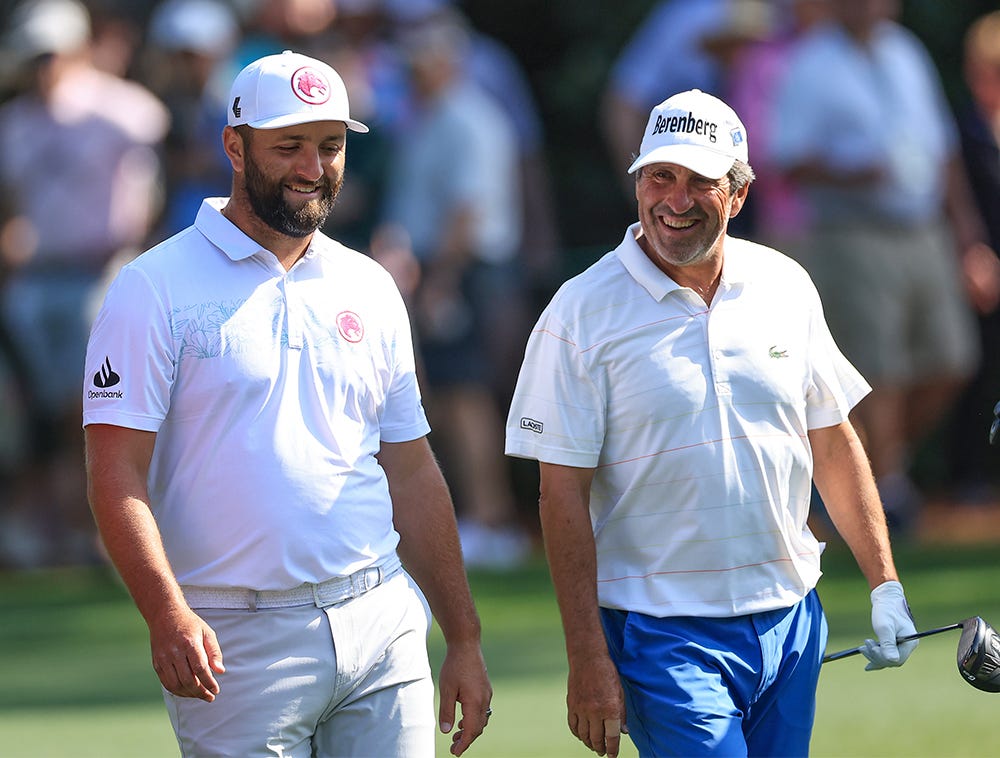Fortune and fate collide in Mexico
Campbell changes career with second chance; Olazábal speaks out on Rahm, LIV
Brian Campbell and girlfriend, Kelsi, celebrate long-awaited breakthrough victory (Hector Vivas/Getty Images)
It is not typical that a ticket to the Masters comes bouncing from deep in a jungle that’s out of bounds. But’s that’s exactly how 31-year-old journeyman Brian Campbell earned his first tee time at Augusta National in April via the Mexico Open last Sunday.
Campbell — a veteran of 187 winless starts as a touring pro making his second stint on the PGA Tour as a Korn Ferry graduate — made the most of his second chances. After grinding all Sunday near the top of the leaderboard trying to keep up with booming 20-year-old South African Aldrich Potgieter — the youngest and longest player on tour — as well as a host of other contenders including Aaron Rai, Isaiah Salinda, Stephen Jaeger and others, he found himself going head-to-head with Potgieter in a playoff at VidantaWorld after each posted 20-under par.
The pair parred the par-5 18th in the first playoff hole, so they went back to the tee for another crack at it. Potgieter, the longest driver on the PGA Tour, bombed his tee shot way down the fairway, and Campbell stepped up to hopefully get somewhere within 50 yards of him as he’d been having to do all day.
“Of course it’s hard to look at a guy next to you hitting it 60 to 80 yards past you, but you’ve really just got to stay focused on what you’re there to do and do the best you can,” he said.
His second playoff tee shot was not his best. Campbell watched all his hopes for finally breaking through disappearing with a shanky, screaming driver that was heading well over the OB fence and into a thicket of trees. It was deader than dead — until it wasn’t. The trees instead spit Campbell’s ball out and toward the fairway. He was 100 yards behind Potgieter and in the rough, but he was still alive.
“That was not by design; I don’t recommend going right on that tee shot,” Campbell said. “I was very fortunate to get the bounce, still in play and then got myself back in position. My caddie gave me a perfect number and I trusted it. Gave us a chance against Aldrich, so that was nice.”
Taking what the golf gods gave him, he laid up from 300-plus yards into the fairway 68 yards short of the hole while Potgieter’s towering mid-iron from 218 failed to clear the front greenside bunker. Campbell then stuck a brilliant wedge to just outside 3 feet below the cup. When Potgieter failed to get up and down, missing his birdie chance from 6 feet, Campbell’s calmly rolled in his birdie and then grabbed his girlfirend, Kelsi McKee, as she leapt into his arms.
“Grit, that’s the only word I can think of right now,” Campbell said when asked how he won. “I’m freaking out on the inside right now. To be in this position is so unreal.”
What it means to a long-time grinder securing his first win and all the perks that go with it — two-year exemption through 2027 as well as his first Masters, Players and spots in upcoming $20 million signature events like Bay Hill — was written all over Campbell’s and McKee’s faces. Kelsi fell to her knees crying before running into Brian’s arms.
Picture of the year? Joy is written all over it (Hector Vivas/Getty Images)
“All day, I thought I was going to throw up at multiple times during the day,” Campbell said. “That last hole, I guess I just wanted to keep the party going a little longer but not by design. Yeah, it was really fun to play against (Potgieter). We had some guys further back coming up to get us too, so we had a lot to think about.
“It’s really hard to put it into words. You play so hard, you put your heart out there, you grind not just four days but really all week long we’re out here. So to have it culminate like this has just been really special.”
Fortune and fate pretty much transformed Campbell’s professional career on that playoff hole and sent it in a new direction filled with opportunities he’s only dreamed of until now. Campbell first reached the PGA Tour in 2016-17 after only a year as a professional. but he made only seven of 20 cuts, finishing 180th in points and sent back to the developmental drawing board to try again. It took him eight years to get back as a 2024 KFT graduate.
“I almost stopped golfing about two years ago,” he admitted. “I was at second stage. I made a quad on a par-3 and thought I shot myself out of Q-School. Then somehow managed to fight back the next day and shoot a really nice number, got myself back in it enough to get to final stage. That led to last year and I had a really strong last year. It’s crazy how quickly things can change and I’m so blessed to be in this position.
“It’s been a long time, but I battled threw some injuries for the last couple years. It’s not been easy, I’m not gonna lie. But I just, I don’t even know what to say. It has been so long, it’s been eight or nine years since I’ve been back. I guess I was focused more on getting myself healthy again and really just trying to enjoy golf again, have fun with it. It’s crazy what can happen when you focus on the right things.”
What advice would he give to fellow grinders trying to reach a place he’s finally arrived.
“Trust yourself. You know what you’re capable of, you’ve put in years of hard work,” he said. “It’s not always going to go your way, but you really just got to trust the process, keep digging deep, you know, and just really believe in yourself. It’s hard to do that out here when if you don’t win, you’re a loser. It’s kind of an interesting concept, even second place. So we have to deal with that every week. You’ve really just got to trust yourself, believe in yourself and go take care of business.”
Aldrich Potgiter, the youngest and longest player on tour, knows his “time will come.” (Orlando Ramirez/Getty Images)
Potgieter was the “first loser” last week, and failing to birdie the par-5 18th on either playoff hole cost the former British Amateur champion from making a return to Augusta National where his prodigious length would be fascinating to watch. He has a lot of tightening up with his short game to do to be able to fulfill his promise.
“Hopefully, my time will come soon,” Potgieter said.
“Pressure’s a big thing. You can’t really beat it, you just have to learn and adjust to it next time you’re in this position again,” he added. “I’m really happy with how I played this week and trying to do that the following week I guess. If you told me I would get second place before the week started, I would definitely have taken it. We’re just happy to have gotten into a playoff. The way I played today wasn’t my best and I was having to chase the whole time and it was nice to see some good results in the last five, six holes of the tournament.”
Campbell brings the 2025 Masters field to 91 players — 19 of them debutantes.
Spanish Masters champions Jon Rahm and José María Olazábal (David Cannon/Getty Images)
Olazábal: ‘It’s a shame how divided it is’
José María Olazábal is one of golf’s most thoughtful champions. The two-time Masters champion )1994 and 1999) has always been an old soul in the game he deeply loves. He’s quick with words of encouragement for young players and quicker with tears when he speaks of his mentor, friend and partner Seve Ballesteros or of his passion for Ryder Cup. He will return to play the Masters for possibly the last time in April, but he will hopefully be a presence under the tree at Augusta or at the Champions Dinner table for many years to come.
In a relatively rare interview with Juan Morenilla that published in Spain’s El País newspaper last week, Olazábal had some strong things to say about what LIV Golf has done to the game of golf and what his young countryman Jon Rahm may have sacrificed by taking the money and joining the breakaway closed-circuit league. Quotes used from Morenilla’s interview have been translated from original Spanish.
While saying he respected Rahm’s personal decision to accept hundreds of millions in life-changing wealth to secure his family’s future – “If you had put a check in front of me with a bunch of zeros on it, I might have done it, too,” – he bemoans the professional cost that decision may have taken on the former world No. 1 and two-time major winner (2021 U.S. Open and 2023 Masters) as he has fallen outside the top 50 in the Official World Golf Rankings.
“He had an extraordinary future and the opportunity to make history in this sport, to write golden pages of golf. And I don’t know if he will be able to do it now.”
— José María Olazábal on Jon Rahm
“I was surprised because Jon had been very clear in his words and because he had an extraordinary future and the opportunity to make history in this sport, to write golden pages of golf,” Olazábal said. “And I don’t know if he will be able to do it now. I don’t know if playing the LIV is the best preparation to be able to stand out in the big ones.
“From my point of view it is not the best option. Above all it can harm him in terms of competitiveness. I don't question Jon’s self-esteem, work and attitude at any time. When he gets to the Masters this year he will give it his all and he will prepare himself in the best way. But the rest of the season, playing 12 or 14 tournaments without a cut, with 54 players ... it is not the same as playing against 150 and knowing that you can go home.
“I am terribly sorry that Jon is not among the top 50 in the world. He is a great player and should be fighting with (Scottie) Scheffler every week to win everything.”
The state of the game in general since LIV forced a rift at the top distresses Olazabal.
“It’s a shame how divided it is. It’s very difficult to solve. We all notice it,” he said. “Before there was a status quo that wasn’t perfect, but that met the needs of the public. Today that doesn’t happen because of the division between LIV and the other circuits. It makes me sad. Golf is a wonderful, attractive sport, and now not being able to see the best together makes you lose a bit of interest.”
Olazábal also believes the LIV product itself is inferior to the traditions of the merit-based game.
“Call me traditional, but I don’t like the format,” he said. “I don’t like the fact that they all come out at the same time, in three days, without a break, with all that paraphernalia around them, the music. ... It makes me sad that money has divided golf. It’s because of money, there’s no doubt about it. … It’s a shame that money has destroyed in such a short time what had been built up over so many years.”
He also believes his late friend Ballesteros would not appreciate what LIV has done even though Seve waged many pitched battles of his own with tour leadership over his right to play where, when and for how much he wanted.
“He was a defender of being able to play wherever you wanted, but history was also very important to him, leaving a mark, marking an era,” Olazábal said. “And I think LIV is not going to give you that.”
Olazábal sees a major difference between young golfer of today and the players of his generation, but he wouldn’t change a thing about the time and place when he was at his best.
“We were more innocent, we didn’t have the knowledge that young people have today,” he said. “You had to play with Nick Faldo or Seve and you arrived feeling inhibited, scared. This generation is not afraid. They are better prepared thanks to all the information they have. And they have a huge confidence in themselves because they rely on numbers and data. Doubt disappears. Necessity made us players.
“But if I had to choose, I’d stick with the era I lived in. It was an adventure, you didn’t know what was out there, there were no facilities. In the first years on the European circuit I had to travel with my bag of balls, find a place among the caddies, there were no official hotels or courtesy cars. We made a living. That’s prehistory. Today everything is more professional, there is no room for gaps. And something saddens me: we have lost the coexistence, the personal relationships. Before, after playing we would go to the hotel, play cards and tell each other about our lives. Today they have no time for anything, it is full dedication.”







